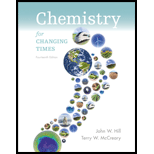
a)
Interpretation:
Deuterium must be defined.
Concept Introduction:
An atom is smallest constituent unit of any kind of matter. It determines the properties of all kinds of matter.
It is made up of three kinds of sub-atomic particles: Protons, neutrons and electrons.
Protons and neutrons are heavier than electrons. They are present in the center of the atom inside the nucleus. Protons and neutrons both have nearly same mass. Protons are positively charged particles while neutrons are neutral that is they possess no charge. Negatively charged electrons are orbiting around the nucleus.
Atoms of same element can have different number neutrons in its nucleus, such atoms with same number of protons but different number of neutrons are called isotopes.
b)
Interpretation:
Tritium must be defined.
Concept Introduction:
An atom is smallest constituent unit of any kind of matter. It determines the properties of all kinds of matter.
It is made up of three kinds of sub-atomic particles: Protons, neutrons and electrons.
Protons and neutrons are heavier than electrons. They are present in the center of the atom inside the nucleus. Protons and neutrons both have nearly same mass. Protons are positively charged particles while neutrons are neutral that is they possess no charge. Negatively charged electrons are orbiting around the nucleus.
Atoms of same element can have different number neutrons in its nucleus, such atoms with same number of protons but different number of neutrons are called isotopes.
c)
Interpretation:
Photon must be defined.
Concept Introduction:
Photon is an elementary particle. It possess wave particle duality. It has zero mass and its speed is equal to
Want to see the full answer?
Check out a sample textbook solution
Chapter 3 Solutions
Chemistry For Changing Times (14th Edition)
 ChemistryChemistryISBN:9781305957404Author:Steven S. Zumdahl, Susan A. Zumdahl, Donald J. DeCostePublisher:Cengage Learning
ChemistryChemistryISBN:9781305957404Author:Steven S. Zumdahl, Susan A. Zumdahl, Donald J. DeCostePublisher:Cengage Learning ChemistryChemistryISBN:9781259911156Author:Raymond Chang Dr., Jason Overby ProfessorPublisher:McGraw-Hill Education
ChemistryChemistryISBN:9781259911156Author:Raymond Chang Dr., Jason Overby ProfessorPublisher:McGraw-Hill Education Principles of Instrumental AnalysisChemistryISBN:9781305577213Author:Douglas A. Skoog, F. James Holler, Stanley R. CrouchPublisher:Cengage Learning
Principles of Instrumental AnalysisChemistryISBN:9781305577213Author:Douglas A. Skoog, F. James Holler, Stanley R. CrouchPublisher:Cengage Learning Organic ChemistryChemistryISBN:9780078021558Author:Janice Gorzynski Smith Dr.Publisher:McGraw-Hill Education
Organic ChemistryChemistryISBN:9780078021558Author:Janice Gorzynski Smith Dr.Publisher:McGraw-Hill Education Chemistry: Principles and ReactionsChemistryISBN:9781305079373Author:William L. Masterton, Cecile N. HurleyPublisher:Cengage Learning
Chemistry: Principles and ReactionsChemistryISBN:9781305079373Author:William L. Masterton, Cecile N. HurleyPublisher:Cengage Learning Elementary Principles of Chemical Processes, Bind...ChemistryISBN:9781118431221Author:Richard M. Felder, Ronald W. Rousseau, Lisa G. BullardPublisher:WILEY
Elementary Principles of Chemical Processes, Bind...ChemistryISBN:9781118431221Author:Richard M. Felder, Ronald W. Rousseau, Lisa G. BullardPublisher:WILEY





